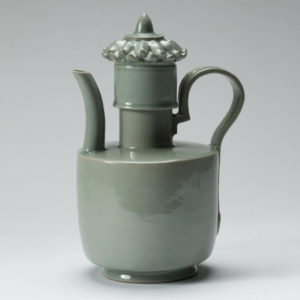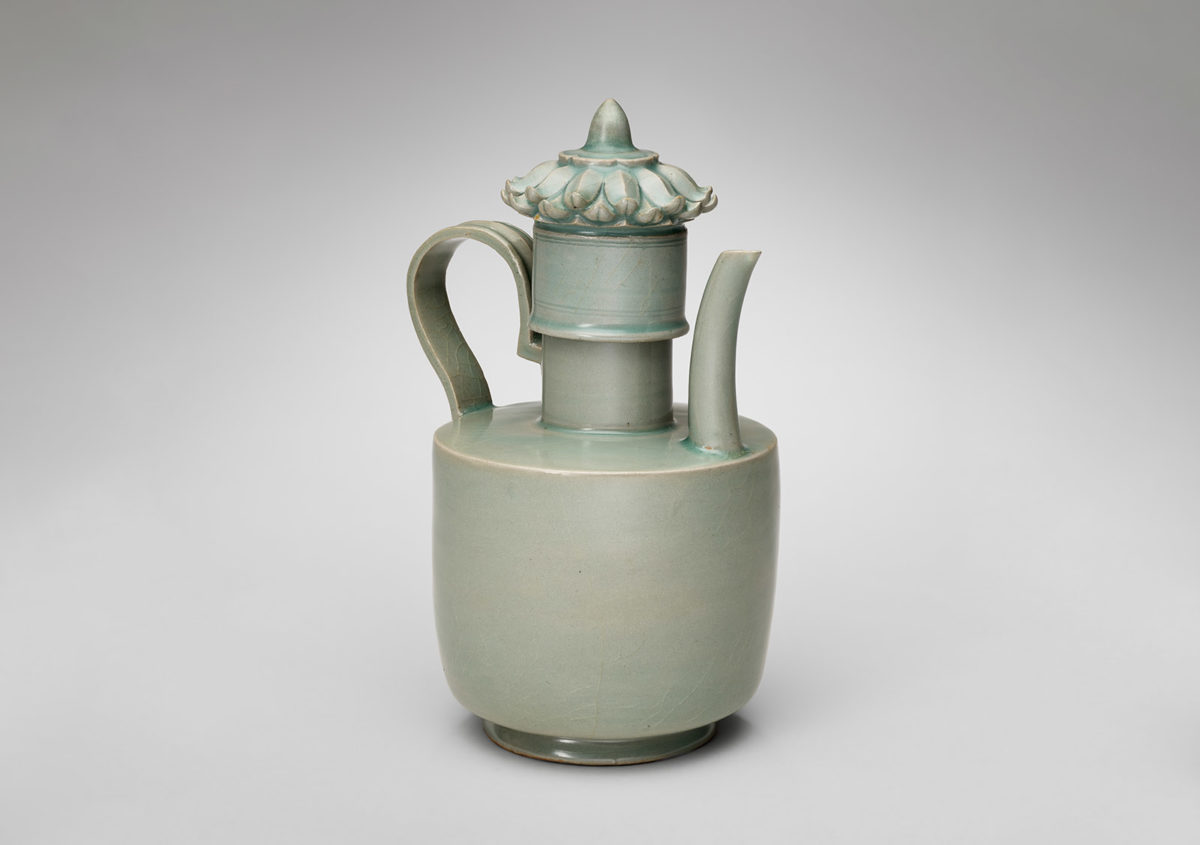Extraordinary color and elegant form unite in this masterpiece of early 12th-century Korean celadon.

Ewer with lotus-shaped lid
Approx. 1050–1150
Korea
Goryeo dynasty (918–1392)
Stoneware with celadon glaze
The Avery Brundage Collection, B60P123+.a–.b
This ewer, with its color, glaze, and surface cracks, represents the pinnacle of Goryeo-dynasty (918–1392) celadon production. The ewer’s lustrous surface is a result of the purest clay, a perfect firing environment, and a masterful application of thin, transparent glaze. The exceptional color of celadons such as this led 13th-century Chinese connoisseur Taiping Laoren to write that they were the “best under heaven.”

The color of the robe worn by Céladon, a character in the 17th-century French novel “L’Astrée” came to be used to describe grey-green and bluish-green stoneware in the Western world. In Korea, the term is cheongja, which originated from a Classical Chinese term meaning “blue-green ceramic.”
Goryeo celadons are admired for their elegant shapes and elaborate decoration, but their color is the most exemplary feature. Phrases like “mysterious color” or “jade color” are commonly used, but they fail to adequately describe the unique greenish-grey hue of Goryeo celadons.
Scholars, scientists, and artists are still working to analyze the precise techniques used to create the unique and extraordinary color of Goryeo celadons. Similar color is achieved by firing the clay in an oxygen-reducing kiln with a glaze containing a low percentage of iron oxide. Firing at hot temperatures of around 1250°C (2282°F), this method results in an extremely smooth surface on the finished ceramic, although many fine cracks in the glaze created during the firing process are typical, even desirable.
The blue-green surface of this ewer is lustrous — its hue was derived from the purest clay, a perfect firing environment, and a thin, transparent application of glaze. The even application of glaze on the exterior, interior, and base indicates the care that went into making this vessel. These elements, and the clean foot ring around the base, suggest that the artisans would have placed the ewer on its own in a single sagger, a boxlike clay container that protects the ceramic during firing and was used to fire precious ceramics of high quality.
During the Goryeo dynasty, most of the kilns were located in coastal cities, including Gangjin and Haenam in South Jeolla province, for easy access to abundant soils and water. Celadon kilns with chamber compartments were installed on slopes. The coastal locations offered ease of sea transport, allowing ceramics to be shipped to other parts of the country, as well as to China. Producing celadons required a high level of technical sophistication and extreme care. As noted by the scholar Yi Gyubo (1168–1241), only one out of ten of these wares met the extremely high standards of the Goryeo court.
The Goryeo rulers established Buddhism as the state belief. Various types of celadon ware, including ewers and bowls, were used for Buddhist rituals. This fine ewer was probably made for aristocrats or a royal family. It likely contained liquid such as wine or water used during religious ceremonies. A similar ewer in the collection of the National Museum of Korea has a basin, suggesting that the Asian Art Museum’s ewer also might once have had a basin.
Scholars of ceramics agree that the most sophisticated celadons were those excavated from the tomb of King Injong (reigned 1122–1146) located in the capital of Goryeo (today’s Gaeseong, North Korea). The Asian Art Museum’s ewer shares many characteristics with four iconic celadons found in King Injong’s tomb in terms of design, proportion, and glaze color, suggesting this ewer might be a product of the same kiln or was intended to be included in the tomb. The four ceramics are now in the collection of the National Museum of Korea. Determining how our ewer left Korea requires further study.
This ewer was an early addition to Avery Brundage’s collection, having been acquired from the famous Japanese dealer Mayuyama Junkichi (1913–1999). It was donated to the Asian Art Museum in 1960. Brundage favored Goryeo celadons among all Korean artworks.
In the mid-20th century, Avery Brundage (1887–1975) was known as a major American collector of Korean art on the West Coast of the United States. His donations to the Asian Art Museum include various genres of Korean artworks. Among the 213 Korean art objects he donated, the majority are ceramics, such as stoneware, whiteware, and celadon.
The Asian Art Museum’s ewer is almost identical to one owned by the Leeum, Samsung Museum of Art in Seoul, though the knob on the lid of our ewer, lower and simpler in form, is a modern repair. The extraordinary color and elegant form of both ewers indicate that they were made in a similar era, a period during which a set of celadon wares was created to be buried in the tomb of King Injong (reigned 1122–1146). These two ewers exemplify the finest Goryeo celadon ware of the 12th century.